#687 Less shopping, more clarity
The Year of Less: How I Stopped Shopping, Gave Away My Belongings, and Discovered Life is Worth More Than Anything You Can Buy in a Store
by Cait Flanders
Carlsbad, CA: Hay House, 2018
$25.99 (U.S.) / 9781401954871
Reviewed by Natalie Lang
*
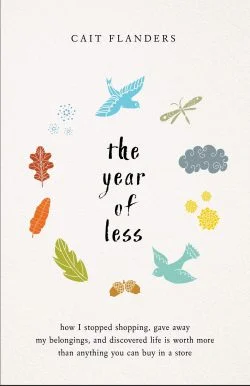 We live in a world where the culture of buying cheap and easily replaceable things has become so normal that we don’t always stop to consider the quality of what we are buying and why we are buying it. In The Year of Less, Squamish writer Cait Flanders dares to ask her readers what they really want. She takes us on a month-by-month journey through her personal challenge to stop shopping for a year. Witty, honest, shockingly familiar, and forcing — at least for me – much self-reflection, Flanders accurately portrays a growing unhappiness in consumers today. Our perception is clouded with all the things we think we need; but as soon as we have them, we find ourselves less happy than before and with less money in the bank. Without an awareness of what and why we buy, we end up consumed by the very things that are supposed to set us free. Flanders urges us to stop and ask, “Do I really need this?” She challenges us to look in the mirror and consider who are, who we want to be, and whether the things we own are helping or hindering us along the way.
We live in a world where the culture of buying cheap and easily replaceable things has become so normal that we don’t always stop to consider the quality of what we are buying and why we are buying it. In The Year of Less, Squamish writer Cait Flanders dares to ask her readers what they really want. She takes us on a month-by-month journey through her personal challenge to stop shopping for a year. Witty, honest, shockingly familiar, and forcing — at least for me – much self-reflection, Flanders accurately portrays a growing unhappiness in consumers today. Our perception is clouded with all the things we think we need; but as soon as we have them, we find ourselves less happy than before and with less money in the bank. Without an awareness of what and why we buy, we end up consumed by the very things that are supposed to set us free. Flanders urges us to stop and ask, “Do I really need this?” She challenges us to look in the mirror and consider who are, who we want to be, and whether the things we own are helping or hindering us along the way.
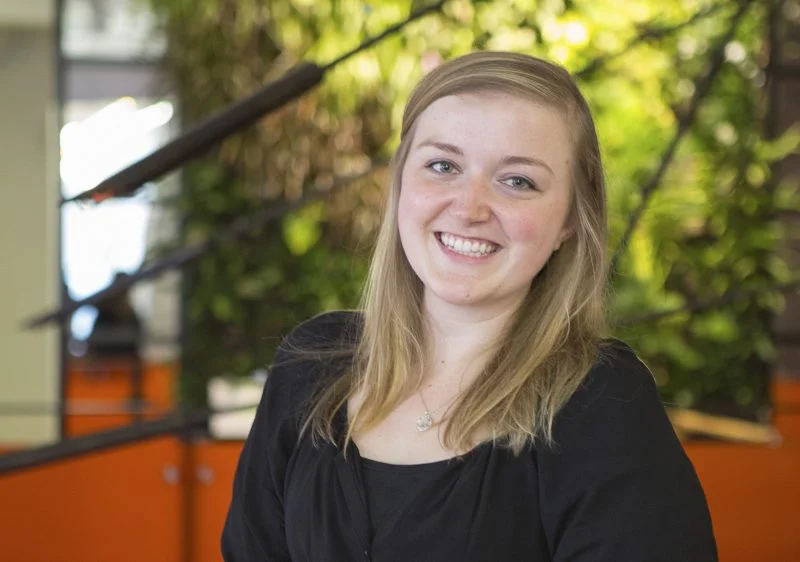
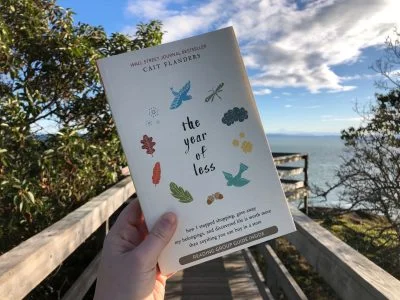
We are habituated to the idea that if we just had that new pair of shoes, the latest phone, or another winter scarf, we might become the person we want to be, or think we should be — as though purchases will make us kinder, gentler, stronger, smarter, prettier, happier, or more professional. Instead, we achieve a growing emptiness in ourselves and often a depletion of our bank accounts. As Flanders goes through her year-long shopping ban, recorded on her blog, she highlights the gritty details of what it took to change her life and spending habits, and offers a guide for anyone looking to do the same.
She also explores the emotive reactions and patterns that appeared when her own life proved challenging and traumatic, and it is here that Flanders’ book really shines. Refreshingly frank and personal, she paints a picture of her childhood, relationships, jobs, friends, issues with sobriety, and debilitating debt. She examines the guilt, trauma, and ideality she has been carrying for years. Beautifully intertwining key moments in her life with the ups and downs of her total shopping ban challenge, Flanders reveals what she felt when the things she owned or purchased could no longer mask the pain that lurked within: “The toughest part of not being allowed to buy anything new wasn’t that I couldn’t buy anything new — it was having to physically confront my triggers and change my reaction to them.”
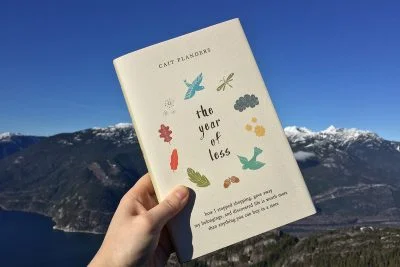
Flanders provides a detailed documentation of the vices in her daily life, their connection to her past, and her new regime of calculating spending and saving and gaining confidence through her shopping ban challenge. In each chapter, marked by months of the year, Flanders notes the percentage of income she has saved and the total percentage of belongings she has thrown out or given away. She documents her life as she achieves her goals. With her Type A skillset, she creates a list of approved shopping items to stay focused throughout the year. She refers often to her list, which includes consumables like groceries, toiletries, and items that need to be replaced because they are worn out or broken. The list is a guidepost to keep her on track and a reminder of how much she has already given away, and how much she still has.
For Flanders, organizing and setting goals keeps her accountable, especially when the ghosts of a consumer’s past told her that “A little couldn’t hurt!” or “It’s on sale!” She started to understand her compulsion to shop when forced to document everything she had, was given, kept, stored, and gave away, and to ask why she hung onto things while buying more, which only created more debt. Asking why we buy things is rarely on our minds when we embark on a shopping trip, but Flanders learned to question why she felt the need, for example, to buy two bottles of shampoo just because they were on sale when she already had two half-empty ones at home. We need to question our purchases constantly, especially when we are lost amid piles of things that were meant to make us happy. They create more misery as they form permanent leaks in our bank accounts.
The Year of Less has an undeniable relevance in our consumerist world. We are constantly bombarded with advertisements telling us how to become the version of ourselves we think the world wants to see. Instead of becoming that version, we stray farther from who we are. We lose sight of what is enough — and whether we are enough without our stuff. We need to ask ourselves hard questions to battle mass advertisements and the lure of shiny objects, new clothes, and fun gadgets that are supposed to make us happier. In short, we must ask whether what we propose to buy is adding or taking away value in our lives.

Flanders — author, retired blogger, and former binge consumer — went looking for a more mindful way of living in The Year of Less, and ended up with less stuff and a newfound mindfulness and self-awareness. If you have a difficulty saving money, resisting another pair of shoes, or buying coffee three times a day, pick up The Year of Less. Cait Flanders provides a strong and clear voice in a world that screams to have more, buy more, and be more. Let this book be your white flag, a call for a ceasefire and peace between what you already have, what you don’t need, and the elusive happiness you’ve been told results from the purchase of just one more thing.
Regardless of where you are on your journey toward a happier and more satisfied self, The Year of Less offers practical skills in financial goal setting. If you seek to be inspired, set boundaries and goals, and understand your true needs as a consumer, you might find the support you require in this book. A satisfying and page-turning read, Cait Flanders’ The Year of Less provides tips on how to start a pilgrimage to financial recovery, to stay accountable, and to discover the space and freedom to ask difficult consumerist questions that might change your life. In your journey through this book, you might even discover something you didn’t know you’d lost: yourself, precisely as you are.
*
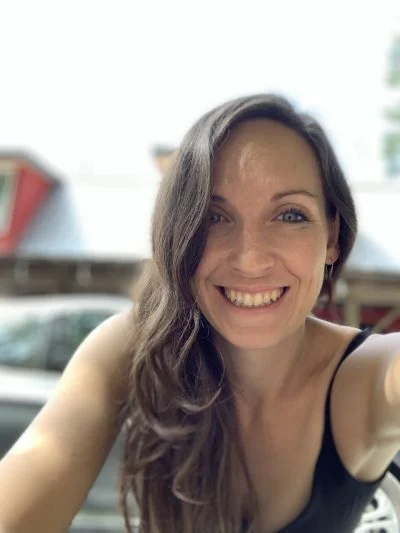
Natalie Lang is a teacher at Rick Hansen Secondary in Abbotsford. She graduated from the University of the Fraser Valley with a Bachelor of Arts degree in English Literature and Anthropology and then completed the PDP (Professional Development Program) and Bachelor of Education at Simon Fraser University. She is now a master’s student in the GLS (Graduate of Liberal Studies) program at Simon Fraser University. Natalie lives to the beat of her own drum, allowing experience and life circumstances to help determine where she goes, what she does, and how she lives. As such, she has lived in China, walked across Spain, and travelled to many areas of the world. Natalie now lives in a renovated barn in the Fraser Valley where she can be found studying for her GLS classes, designing lessons for her students, listening to records, and dabbling with her own experiments in writing.
*
The Ormsby Review. More Books. More Reviews. More Often.
Publisher and Editor: Richard Mackie
The Ormsby Review is a journal service for serious coverage of B.C. books and authors, hosted by Simon Fraser University. The Advisory Board consists of Jean Barman, Robin Fisher, Cole Harris, Wade Davis, Hugh Johnston, Patricia Roy, David Stouck, and Graeme Wynn. Scholarly Patron: SFU Graduate Liberal Studies. Honorary Patron: Yosef Wosk. Provincial Government Patron since September 2018: Creative BC
“Only connect.” – E.M. Forster
One comment on “#687 Less shopping, more clarity”